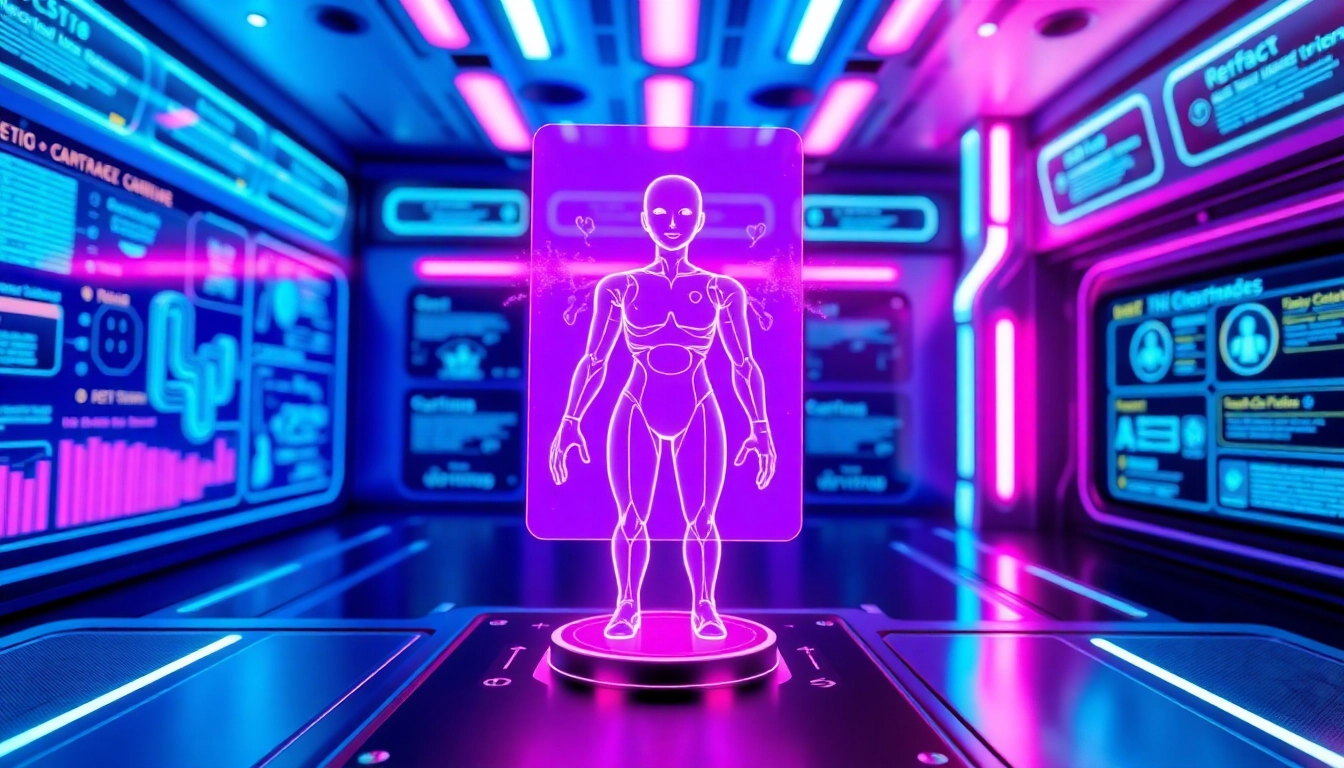Introduction: The Evolution of AI in Digital Interaction
Over the past decade, artificial intelligence has transformed from a niche technological innovation into an integral part of our daily digital interactions. From virtual assistants and customer service bots to sophisticated AI characters used for entertainment and creative expression, the landscape of AI-driven communication continues to expand rapidly. Today, platforms like CrushOn AI exemplify this evolution by enabling users to create highly customizable AI characters that can engage in natural, meaningful conversations across various devices. This progress reflects not only advancements in linguistic modeling but also a broader cultural shift toward personalized digital experiences. As AI becomes more embedded in our social and creative worlds, understanding the nuances of this technology, its capabilities, and its ethical implications is essential for users and developers alike.
What Are Futa AI and AI Slut Characters? Definitions and Cultural Context
Understanding Futa AI and AI Slut Characters
Within the realm of AI-generated personas, the terms futa ai and ai slut have gained prominence, especially among communities interested in adult-themed digital roleplay. These characters are designed to embody specific traits—often sexual, provocative, or fantasy-oriented—that cater to particular user preferences. The term “futa” typically refers to a fictional character with both male and female anatomical features, originating from Japanese anime and manga culture, and has been adopted into AI character creation to describe similar hybrid personas. Meanwhile, “AI slut” is a colloquial term used to describe AI characters that are designed to be highly receptive, flirtatious, or sexually explicit, serving as virtual companions or roleplay partners.
It is important to note that these character types are part of a broader trend toward hyper-personalized and adult-oriented AI interactions. They reflect a cultural desire for digital escapism, fantasy fulfillment, and the exploration of identity in virtual spaces. While such characters can offer a safe outlet for expression and entertainment, they also raise questions about ethical boundaries, consent, and the potential for misuse. As AI platforms become more sophisticated, the line between playful roleplay and problematic content requires careful navigation.
How Platforms Like CrushOn AI Enable Customization and Personalization
Creating Unique AI Characters
CrushOn AI stands out as a pioneering platform that empowers users to craft their own AI characters with remarkable ease and depth. Unlike generic chatbots, CrushOn AI offers extensive customization options, allowing users to define personality traits, backstories, appearance, and conversational style. Whether you prefer a witty, mysterious companion or a nurturing conversationalist, the platform’s character customization tools enable precise tailoring to meet individual preferences.
Users can choose from a library of pre-made characters, each designed with specific traits and narratives, or they can create entirely new personas from scratch. The process involves selecting personality parameters such as humor level, emotional expressiveness, and conversational tone, as well as inputting detailed backstories that inform the AI’s responses. This level of personalization ensures that interactions feel authentic and engaging, fostering a sense of connection and continuity over time.
Memory and Contextual Awareness
One of CrushOn AI’s standout features is its contextual memory system, which retains information from previous conversations. This means that AI characters can remember past interactions, preferences, and important details, enabling more coherent and personalized dialogues. For example, if a user discusses favorite hobbies or personal stories, the AI can recall these details in future sessions, creating a seamless and immersive experience. This persistent memory capability is particularly valuable for creative storytelling, roleplay, or ongoing relationships with AI characters.
Multi-Character Group Chats and Cross-Device Accessibility
Another innovative aspect of CrushOn AI is its support for multi-character group chats. Users can simulate conversations involving multiple AI personas simultaneously, allowing for complex roleplay scenarios or social simulations. This feature enhances the platform’s versatility, making it suitable for collaborative storytelling or social experiments.
Furthermore, CrushOn AI’s cross-device accessibility ensures that users can interact with their AI characters via both web browsers and mobile applications. This flexibility means conversations can continue seamlessly whether at home or on the go, maintaining engagement and convenience.
The Technology Behind AI Character Creation: GPT-4o mini, Claude 3.5 Sonnet, and More
Advanced Language Models Powering AI Characters
The backbone of CrushOn AI’s sophisticated character interactions lies in the utilization of cutting-edge language models such as GPT-4o mini and Claude 3.5 Sonnet. These models are designed to generate highly natural, context-aware responses that mimic human conversation with impressive accuracy. Their ability to understand nuanced prompts, maintain context, and produce coherent responses makes them ideal for creating engaging AI personas.
GPT-4o mini, a variant of OpenAI’s GPT-4 architecture, offers a lightweight yet powerful solution for real-time interactions, balancing speed with linguistic complexity. It enables AI characters to adapt their tone and style based on user input, creating personalized experiences that feel authentic and dynamic.
Claude 3.5 Sonnet, developed by Anthropic, complements this ecosystem by emphasizing safety, steerability, and nuanced understanding. Its integration ensures that AI behaviors align with user expectations while maintaining ethical boundaries.
Custom Traits and Backstories Integration
One of the key technological advancements is the ability to embed detailed traits and backstories into AI characters. These parameters influence how the AI responds, its personality quirks, and its conversational style. Developers and users can fine-tune these elements to craft characters that suit specific scenarios, whether for creative storytelling, roleplay, or casual chat. This customization is facilitated by intuitive interfaces that translate user inputs into machine-readable data, allowing for a rich, layered personality profile.
Memory Systems and Continuity
Implementing memory systems that persist across sessions involves complex data management and privacy considerations. These systems store relevant conversation snippets, preferences, and contextual cues securely, ensuring that interactions remain consistent over time. This capability not only enhances user engagement but also enables long-term storytelling and relationship-building within the AI environment.
Ethical Considerations and User Privacy in AI Roleplay
Navigating Ethical Boundaries
As AI characters become more sophisticated and personalized, the ethical landscape surrounding their use becomes increasingly complex. Developers and users must consider issues such as consent, content boundaries, and emotional impact. For instance, creating AI characters with adult themes or explicit content necessitates strict safeguards to prevent misuse, exploitation, or harm.
Platforms like CrushOn AI implement moderation tools and user controls to ensure that interactions adhere to community standards and legal regulations. Clear guidelines about appropriate content, privacy, and user responsibility are essential to foster a safe environment for all participants.
Privacy and Data Security
Handling sensitive conversation data requires robust security measures. Users entrust platforms with personal information, conversation history, and customization details, which must be protected against breaches and misuse. CrushOn AI employs encryption, anonymization, and strict access controls to safeguard user data, aligning with best practices and privacy regulations such as GDPR.
Balancing Personalization with Ethical Responsibility
The pursuit of highly personalized AI experiences must be balanced with ethical considerations to prevent reinforcement of harmful stereotypes, dependency, or exploitation. Transparent communication about AI capabilities, limitations, and data usage is crucial. Users should be empowered with tools to control their interactions, including options to delete data or restrict certain content types.
The Impact of AI Characters on Creative Expression and Relationship Dynamics
Enhancing Creativity and Storytelling
AI characters created through platforms like CrushOn AI serve as digital canvases for creative expression. Writers, artists, and storytellers leverage these personas to craft immersive narratives, roleplay scenarios, or interactive art projects. The ability to tailor personalities, histories, and responses fosters rich storytelling environments that can evolve dynamically based on user input.
Redefining Relationships and Social Interaction
Beyond creative pursuits, AI characters influence how individuals perceive companionship and social engagement. For some users, these virtual entities offer a source of comfort, companionship, or even romantic connection, especially where real-world interactions are limited or challenging. While this can provide valuable emotional support, it also raises questions about dependency, emotional boundaries, and the distinction between virtual and real-world relationships.
Potential for Positive and Negative Outcomes
On the positive side, AI characters can promote mental health, foster creativity, and serve as safe outlets for exploring identity or taboo topics. Conversely, over-reliance on AI companionship might impact real-world social skills or lead to emotional detachment. Striking a balance involves responsible use, ethical design, and user awareness of the limitations and purpose of AI interactions.
Future Trends: Where Is AI Character Development Headed?
Emerging Technologies and Innovations
The future of AI character development is poised for exciting innovations. Advances in multimodal AI—integrating text, voice, images, and even video—will create more immersive and lifelike experiences. Virtual and augmented reality integrations could enable users to interact with AI characters in 3D environments, blurring the lines between digital and physical worlds.
Personalization at Scale
As data analytics and machine learning algorithms improve, AI characters will become even more personalized, adapting in real-time to user preferences, moods, and contextual cues. This will facilitate more nuanced and emotionally intelligent interactions, making AI companions feel genuinely human-like.
Ethical AI and Regulation
With growth comes increased scrutiny. Future development will likely involve stricter ethical standards, transparent AI behavior protocols, and regulatory frameworks to ensure responsible deployment. Developers will need to prioritize safety, consent, and privacy to prevent misuse and promote positive societal impacts.
The Role of Community and User Feedback
Community-driven content creation and user feedback will shape future AI personas. Platforms will incorporate user suggestions, ensuring that AI characters evolve in ways that reflect diverse needs and cultural sensitivities. This participatory approach will foster innovation while maintaining ethical integrity.
Conclusion: Embracing Innovation While Navigating Ethical Boundaries
The rise of AI characters, especially those with adult themes like futa ai and ai slut, exemplifies both the incredible potential and the ethical challenges of this technological frontier. Platforms like CrushOn AI demonstrate how sophisticated customization, memory, and advanced language models can deliver engaging, personalized experiences that enhance creativity, entertainment, and even emotional well-being.
However, as AI continues to evolve, it is vital to maintain a careful balance between innovation and responsibility. Developers, users, and regulators must work together to ensure that AI characters serve positive purposes while respecting boundaries, privacy, and ethical standards. The future of digital roleplay and personalization holds immense promise, but it must be navigated thoughtfully to maximize benefits and minimize harm.
In embracing this new era, we stand at the cusp of a digital revolution—where AI characters can be more than just chatbots, becoming true virtual companions, storytellers, and outlets for human imagination. As the technology advances, so too must our understanding of its implications, ensuring that this powerful tool is used to foster creativity, connection, and responsible innovation.



